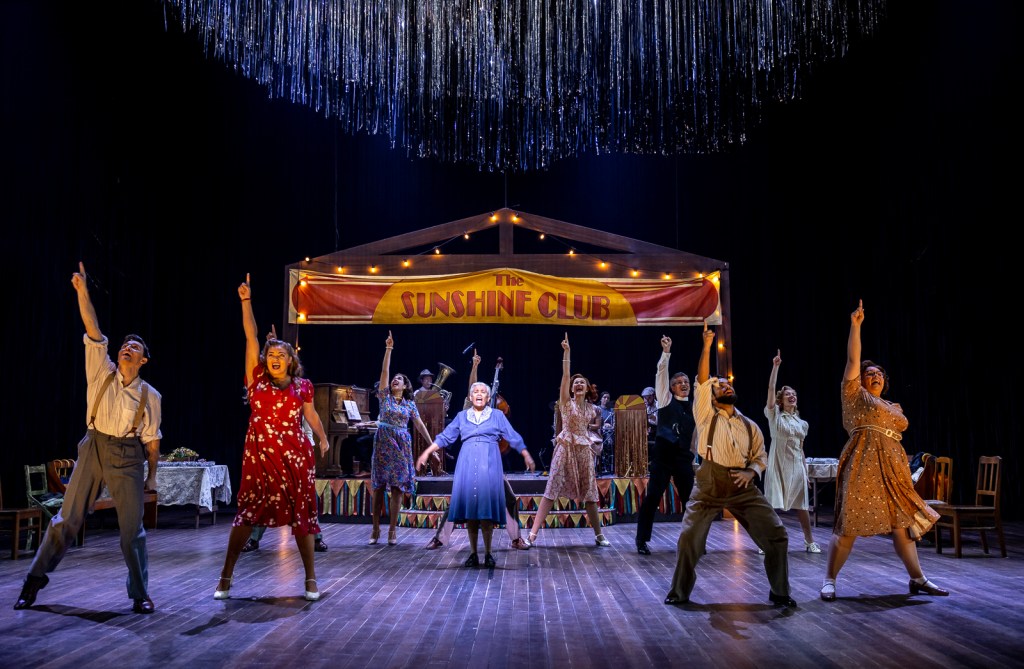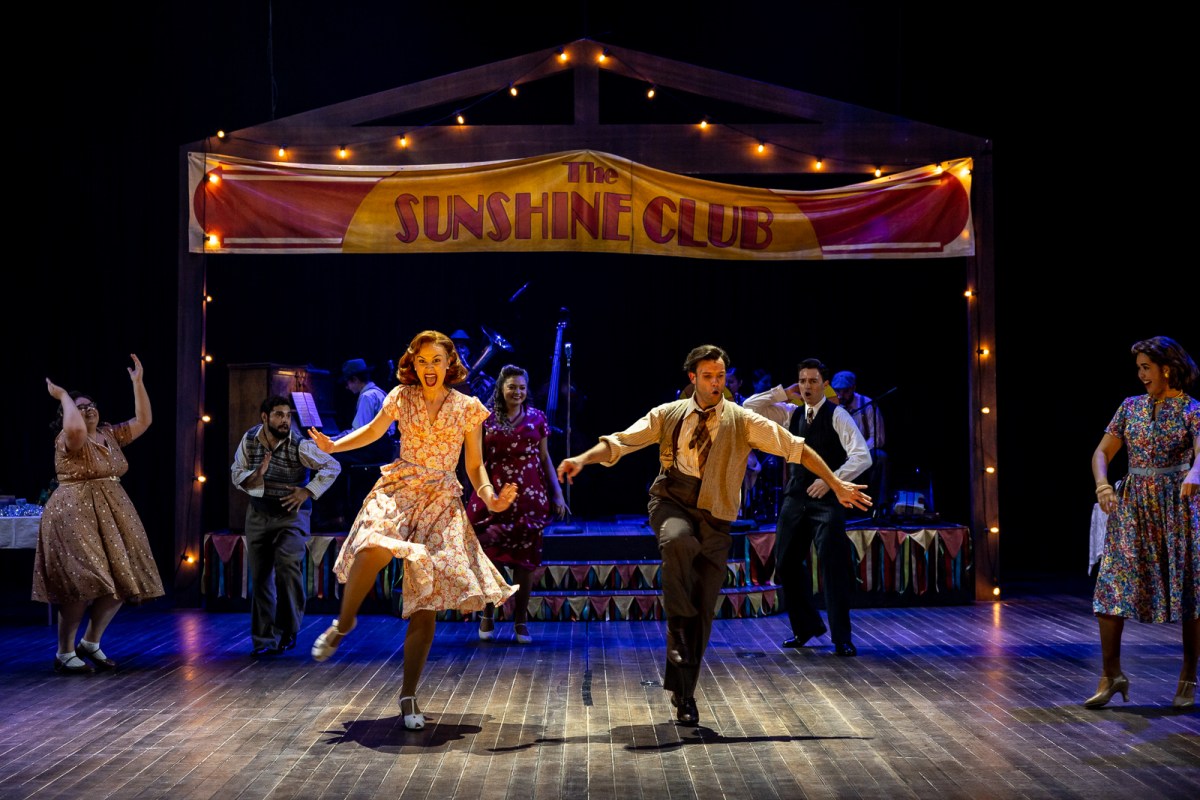Having been commissioned by then Artistic Director of Queensland Theatre Company, Robyn Nevin, writer and director Wesley Enoch and composer, John Rodgers, first presented The Sunshine Club in Brisbane in 1999. Described as ‘an unashamedly feel-good musical’ the story is as topical and relevant today as it was over 20 years ago, given the current political discussions about the Uluru Statement from the Heart and a treaty with Indigenous people. It also touches on how far we have come, or perhaps not come, in determining racial equality. This revival is therefore timely and important.
Set in 1946, shortly after the end of the Second World War, The Sunshine Club tells the story of an Indigenous soldier, Frank Doyle (Marcus Corowa) who returns home from the horrors of war optimistically hoping for a new and better life. However, little has changed from the world he left behind a few years earlier. Having contributed to the war effort with equal status in the army alongside his white Australian mates, he comes back to find that he must continue living under segregation and a curfew, with restricted right of movement on his side of the Brisbane River.
The racial double standards that veterans faced was shamefully all too real, and has been the subject of a number of plays, including Enoch’s own production of Black Diggers in 2014. The White Australia policy that was in force until 1967 meant Doyle was unable to enter venues such as the famous Brisbane ballroom, Cloudland.
Proudly refusing to enter the dance hall when Reverend Morris father of his neighbour and friend Rose, tries to obtain an exemption for him, Frank decides on another course of action. Seeing how popular dance clubs were at the time, and thanks to Morrison who allows him to use the church hall on a Saturday night, he decides to open his own non-discriminatory Sunshine Club. With no racial restrictions on entry, the club becomes a desirable meeting place for many young people with its offering of entertainment alongside the jazz and popular music of the time.
Enoch wrote both the book and lyrics, as well as being the director. One can sense that the theme is a subject dear to his heart in this heart-warming but equally tragic story of one man’s struggle to find justice in an unjust world. The Sunshine Club is about racial inequality but it also touches on female gender inequality as well as oppression, violence and police brutality.
The story is told in the genre of a musical, suiting the dance club theme but giving it another layer of complexity. Despite some clunky dialogue and mixed singing and dance skills from the cast, the song and dance delivery around intertwining love stories makes for a compelling story of humanity, hope and despair. Enoch directs the overall ensemble and individual performers with finesse and sensitivity, the fast-moving production well managed and staged.
Set designer Jacob Nash has created some fluid settings, changing easily from garden and domestic scenes in and out of the celebratory club atmosphere. A glittering silvery curtain, used to split the use of the fore and back stages, cleverly and effectively becomes part of the club itself.
Lighting by Ben Hughes is evocative and atmospheric, time and place perfectly differentiated. Richard Roberts’ costumes are splendid; the style and feel of the 1940s designed with great attention to detail. The flowing dresses and wide skirts of the girls are well-matched by the baggy suits and felt hats of the men.

John Rodgers’ music with its upbeat dance tunes have the jive, bunny hop and ballroom dancing steps of the period at their core. The songs have a jazz swing and rhythm to them, with some memorable tunes, not least the title song, ‘The Sunshine Club’, full of hope and joy, and the yearning finale, ‘If Not Now Then When?’
The five musicians are included in the action within the club on a moving bandstand. They are all first-rate, including the original Musical Director, Wayne Freer, reprising his role and additionally playing both bass, trombone and euphonium. He is joined by talented jazz pianist, Stephen Newcomb, Katie Randall excelling on drums, the marvellous trumpet and piano accordion of Michael Whitaker and a fine saxophonist in Mika Anderson.
Back in 1999 the cast included several first-time mainstage Indigenous artists, many of whom have since become household names. Roxanne McDonald is the only artist from the original production to reprise her role, giving a finely nuanced performance as Aunty Faith Doyle while offering both wisdom and her own brand of philosophy, although perhaps she should not have been given a solo song.
The key role of Frank Doyle, played with great panache by Marcus Corowa, demonstrated strong vocals offering a mix of idealistic charm and happy-go-lucky optimism that finally gave way to deep-seated anger in his powerfully interpreted final song ‘Homecoming.’ As his love interest, Rose Morris, Irena Lysiuk was wide-eyed and vivacious, her naivety making her blissfully unaware of racial issues. With a lovely soprano, she moved beautifully on stage and was well matched with Corowa. They made a perfectly believable couple.
Naarah played Frank’s sister, Pearl, as a tough girl-about-town, strong on one-liners and jealous of Rose whose opportunities to be a singer she could only dream of. Naarah gave a moving performance as a girl betrayed, passionately delivering the haunting song ‘Passionfruit Vine’.
Read: Theatre review: Looking for Alibrandi
Trent Owers made the most of his sleazy salesman, Peter Walsh, who seduces Pearl, his singing and dance skills some of the best in the show. Beau Dean Riley Smith was very funny and impressed as Dave Daylight, but his song about Menzies was ill-conceived vocally and failed to have impact. As Reverend Morris, Andrew Buchanan was luxury casting and gave a strong performance. Zoe Walters as Mavis, Jazleen Latrise as Audrey, Kate Yaxley as Patti with Colin Smith as Pauly and Garret Lyon as Lorry were a solid ensemble with good vocal harmonies and competent dance skills.
Choreographer, Yolande Brown, created some lovely stage pictures with the ensemble and got the mood and tempi of the 1940s dance and swing numbers just right.
The ending makes a shift from the original, bringing us into the present day with the cast playing actors within a play and commenting on the outcomes of the story. Without the resolution we might have hoped for, the ensemble finale of ‘If Not Now Then When?’ is a sobering reminder of how far Australia may have come since 1946 but also how far we have to go in reconciling and building a better future for the next generation.
The Sunshine Club
Queensland Theatre in conjunction with QPAC Queensland
Playhouse Theatre, QPAC
Writer and Director: Wesley Enoch
Composer: John Rodgers
Musical Director: Wayne Freer
Choreographer: Yolande Brown
Set and property designer: Jacob Nash
Costume designer: Richard Roberts
Lighting designer: Ben Hughes
Sound/sound system designer: Derek Wilson
Cast: Marcus Corowa, Irena Lysiuk, Roxanne McDonald, Andrew Buchanan, Naarah, Beau Dean Riley Smith, Trent Owers, Zoe Walters, Jazleen Latrise, Colin Smith, Kate Yaxley, Garret Lyon
Musicians: Wayner Freer, Stephen Newcomb, Katie Randall, Michael Witaker, Mika Atkinson
Tickets: $68-$115
The Sunshine Club will be performed until 30 July 2022





